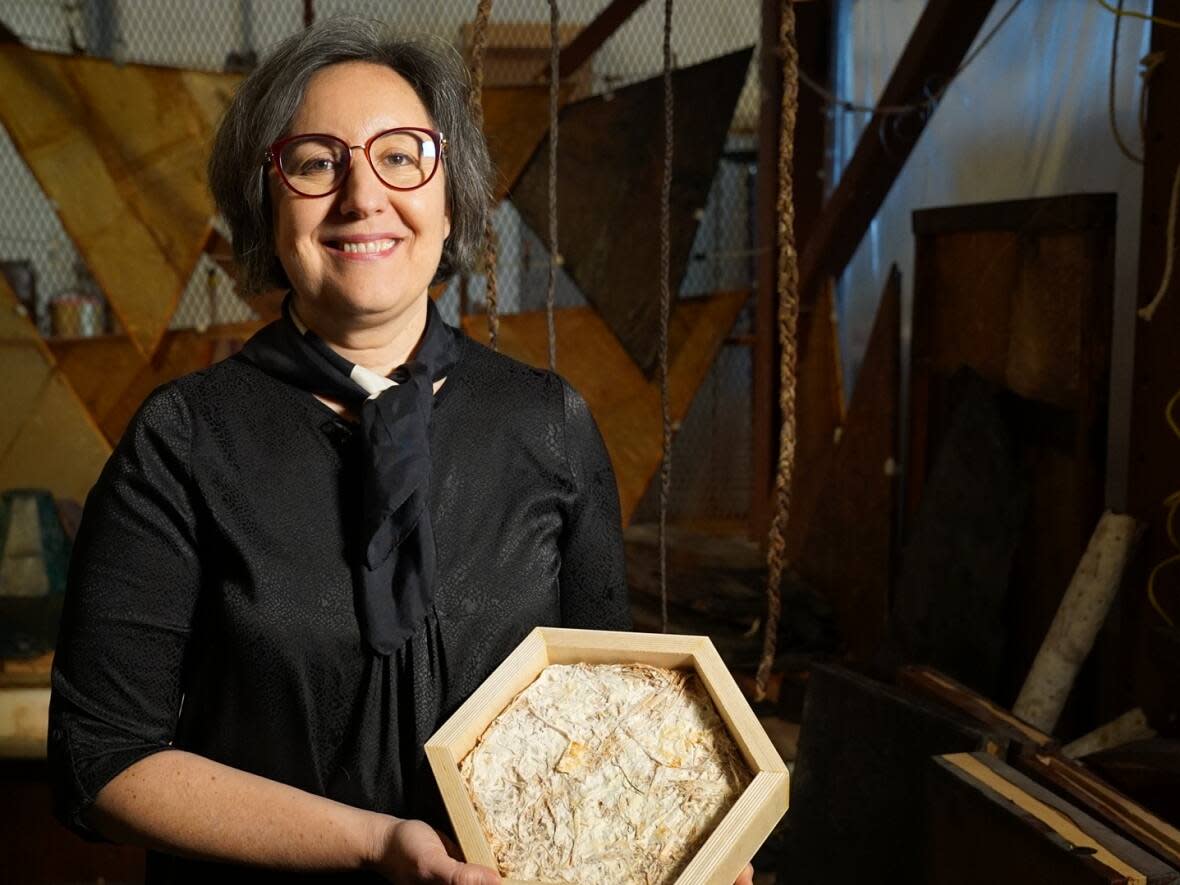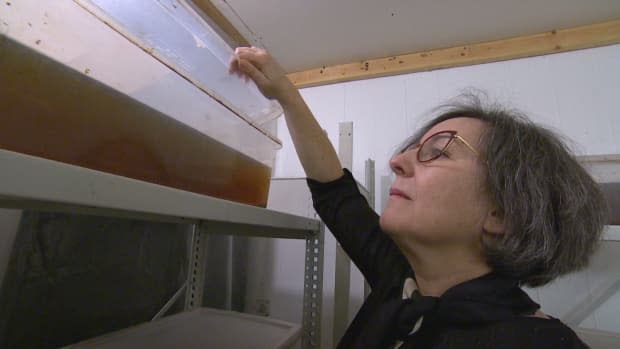Mushroom visions: Manitoba research team grows fungi supplies in hopes of helping housing crisis

A research team at the University of Manitoba is cooking up ideas to help tackle the housing crisis in Manitoba's north, developing new materials made not from steel or concrete — but fungi.
Undergraduate research assistant Dominico Obmerga IV spends a good part of his shifts blending colonies of the fibrous fungi called mycelium with sawdust from a local wood shop.
"I'm putting more mycelium in, so I can get it to half-and-half," said Obmerga, stirring the ingredients together in a large stainless steel mixing bowl.
The concoction, resembling toasted coconut, gets pressed into a mould, where the fungi will eat the sawdust, over time. It's put on a shelf to harden and later put into an oven.
What comes out isn't a cake, but mycelium-made building blocks that researchers hope might change the future of construction.

"It will create this very dense network that acts in many ways as a cement," said the project's leader, Mercedes Garcia-Holguera, holding up a textured, hexagonal brick that looks a bit like concrete mixed with straw.
The team is experimenting with a range of substrates to feed the mycelium, from flax to hemp.
"Manitoba is an agricultural-based province," said Garcia-Holguera, an assistant professor of architecture. "That gives us an opportunity to use part of the agricultural waste as our raw material."
Plants found in northern Manitoba, such as cattails, are also being tested in their mixtures.
"We are interested in biomaterials because it can help us to reduce the environmental impact of traditional and standard materials," said Garcia-Holguera.
As well, "we think that biomaterials can be a very important solution for addressing the housing crisis in remote, isolated communities."
Testing for a Manitoba winter
Researchers are testing the blocks to see how well they weather a Manitoba winter. They say early experiments have been successful, both at the U of Manitoba in Winnipeg and at a test site in Churchill.
The team works out of a tiny hanger in a campus garage, but Garcia-Holguera said any barn or a shed would likely do as a work space. That should help make the process feasible in small, isolated communities, she said.
"You need to harvest during the summer," said Garcia-Holguera. "Then you can store that, and start your growing process maybe during the winter.
"The next summer season, you have your batch of grown materials, ready to be used in construction."
The group is also experimenting with the type of mushroom that makes kombucha.
Garcia-Holguera lifts lids on oblong plastic bins filled with tea, which put out a sweet and pungent odour, a bit like yeasty vinegar.
"Most people have a hard time with the smell," she said, chuckling.
"It's this membrane, this layer that is growing on the top," said Garcia-Holguera, pointing through the translucent bins at some spotty, semi-opaque blotches forming on the surface.

Known by the acronym SCOBY (symbiotic culture of bacteria and yeast), the membrane can be dried and dyed, and fashioned into a variety of shapes, Garcia-Holguera said.
The rustic lab's racks are hung with dark red, green and amber sheets of the bacterial cellulose made from kombucha mushroom.
Garcia-Holguera envisions the sheets as a versatile material for building houses, "maybe for interior panels," she said, pointing to braided strips of the fibre, hanging from the ceiling.
The team even created whimsical-shaped lanterns to celebrate their research, during last fall's Nuit Blanche festival.
"We are also trying to work and see if weaving and braiding can help us improve its tensile strength."
'Plenty of potential'
The research is still highly experimental, but the dream is to have a big impact on people living in remote areas — and on the environment.
"We are very excited," she said, her eyes twinkling. "We think that there is plenty of potential to address housing and material independence for northern and isolated communities."
Garcia-Holguera said her team plans to consult with people in Manitoba's north, to help adapt their materials to suit their needs.
But she said it'll be many years before the fungi-based building supplies are actually put to use.

It's also likely that the materials would have to be replaced on an annual or even seasonal basis.
"[If] our end goal is to build buildings that will last for hundreds of years, of course these materials might not be your best bet," Garcia-Holguera said.
"But those elements of your building will biodegrade naturally faster, and that can bring more life and more nutrients to the site where that building is sitting," she said.
"Then you can start the cycle again. So it requires a change of mindset."
She also pointed out that once the mycelium blocks are formed, the baking process ensures the fungi will no longer grow.
"We kill or deactivate the organic life. Then it's able to be used without any concerns for human health."

Obmerga has been working with Garcia-Holguera throughout most of the project.
"I really like the amount of risk taking that Dr. Mercedes was taking, experimenting with something that's never been really applied in actual building," said the fourth-year student from the university's department of environmental design.
Obmerga said it's the kind of challenge that drew him to architecture.
"There are ecological downsides to creating architecture the conventional way," he said.
"Being part of something that sort of works towards this higher goal, this higher purpose is very gratifying."


